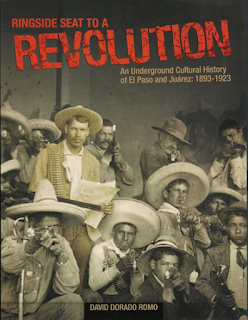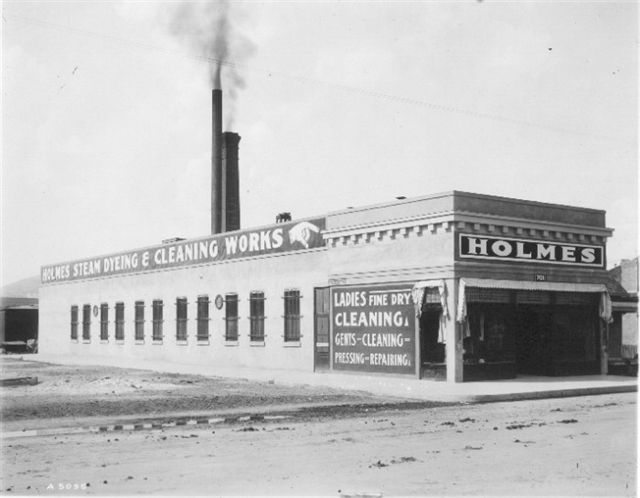Ringside Seat to a Revolution by David Romo

Ringside Seat to a Revolution
An Underground Cultural History Of El Paso and Juárez: 1893-1923
By David Dorado Romo
Truly, the best seats in the house for watching the spectacle of the Mexican Revolution were located along the Rio Grande in El Paso, Texas and its sister city Juárez, Chihuahua. Indeed, these cities—like the city of Boston, Massachusetts, for the American Revolution—served as the intellectual crucible for the Mexican Revolution. This is where the first modern revolution of Latin America began. The heroes and images of this people’s uprising still populate the border’s cultural landscape like ghosts.
But as with so many histories that involve peoples and cultures of color, we’ve always seen the events through the wrong set of eyes. David Dorado Romo—a micro-historian, a man with his feet on both sides of the Rio Grande—gives us new eyes and a re-imagined perspective to witness these revolutionary years. Through detailed research, archival photographs and great storytelling, he relates the history of a long-ignored cultural and political renaissance that was born of the conflict to depose the Díaz Regime and the bloody struggles that followed. His history helps us define fronterizos, a hybrid group of people—not wholly Mexican, not wholly American—who played an essential role in launching the Mexican Revolution. This marvelous cast of characters includes well known characters like the people’s revolutionary, Pancho Villa, who rides his Indian motorcycle through the streets of El Paso; Felipe Angeles who, after a speech of love and prophecy, dies a beautiful death standing before a firing squad; and Teresa Urrea, la Santa de Cabora, who was the spiritual inspiration for so many of the paisanos who gave their lives for Mexico.
But Ringside Seat is also about insurrection from the perspective of the peripheral characters: military band musicians who played Verdi operas during executions in Juárez; filmmakers who came to the border to make silent movies like The Greaser’s Revenge and Guns and Greasers; female bullfighters; poets; jazz musicians; Anglo pool hustlers reborn as postcard salesmen; Chinese illegal aliens; arms smugglers; and, of course, revolutionaries, counterrevolutionaries and counter-counter-revolutionaries.
“David Romo’s Ringside Seat to a Revolution is a fascinating glimpse into unknown scenes of the Mexican Revolution of 1911. He takes us into El Paso and Juárez-facing one another across the Rio Grande-in the years just before and just after the exciting events of the revolution itself. It is close up and personal history-through the eyes of an extraordinary cast of characters. It is ‘people’s history’ at its best.” —Howard Zinn, author of A People's History of the United States
“David Romo’s micro-history is brilliant. Here you’ll find what official history seems to ignore: the salt of the earth, the surprising anecdote, rumors, the absurd.” —Paco Ignacio Taibo II, Mexican historian and author
“This is an extraordinary book. For those who love the tangled history of Texas and Mexico and their tragic border, it’s a treasure.” ―Dallas Morning News
Distributed by Consortium Book Sales
El Paso/Juárez served as the tinderbox of the Mexican Revolution and the tumultuous years to follow. In essays and 240 archival photographs, David Romo tells the surreal stories at the roots of the greatest Latin American revolution: The sainted beauty queen Teresita inspires revolutionary fervor and is rumored to have blessed the first rifles of the revolutionaries; anarchists publish newspapers and hatch plots against the hated Porfirio Diaz regime; Mexican outlaw Pancho Villa eats ice cream cones and rides his Indian motorcycle happily through downtown; El Paso’s gringo mayor wears silk underwear because he is afraid of Mexican lice; John Reed contributes a never-before-published essay; young Mexican maids refuse to be deloused so they shut down the border and back down Pershing’s men in the process; vegetarian and spiritualist Francisco Madero institutes the Mexican revolutionary junta in El Paso before crossing into Juárez to his ill-fated presidency and assassination; and bands play Verdi while firing squads go about their deadly business. Romo’s work does what Mike Davis’ City of Quartz did for Los Angeles—it presents a subversive and contrary vision of the sister cities during this crucial time for both countries.
Truly, the best seats in the house for watching the spectacle of the Mexican Revolution were located along the Rio Grande in El Paso, Texas and its sister city Juárez, Chihuahua. Indeed, these cities—like the city of Boston, Massachusetts, for the American Revolution—served as the intellectual crucible for the Mexican Revolution. This is where the first modern revolution of Latin America began. The heroes and images of this people’s uprising still populate the border’s cultural landscape like ghosts.
But as with so many histories that involve peoples and cultures of color, we’ve always seen the events through the wrong set of eyes. David Dorado Romo—a micro-historian, a man with his feet on both sides of the Rio Grande—gives us new eyes and a re-imagined perspective to witness these revolutionary years. Through detailed research, archival photographs and great storytelling, he relates the history of a long-ignored cultural and political renaissance that was born of the conflict to depose the Díaz Regime and the bloody struggles that followed. His history helps us define fronterizos, a hybrid group of people—not wholly Mexican, not wholly American—who played an essential role in launching the Mexican Revolution. This marvelous cast of characters includes well known characters like the people’s revolutionary, Pancho Villa, who rides his Indian motorcycle through the streets of El Paso; Felipe Angeles who, after a speech of love and prophecy, dies a beautiful death standing before a firing squad; and Teresa Urrea, la Santa de Cabora, who was the spiritual inspiration for so many of the paisanos who gave their lives for Mexico.
But Ringside Seat is also about insurrection from the perspective of the peripheral characters: military band musicians who played Verdi operas during executions in Juárez; filmmakers who came to the border to make silent movies like The Greaser’s Revenge and Guns and Greasers; female bullfighters; poets; jazz musicians; Anglo pool hustlers reborn as postcard salesmen; Chinese illegal aliens; arms smugglers; and, of course, revolutionaries, counterrevolutionaries and counter-counter-revolutionaries.
Praise for Ringside Seat to a Revolution
“Thank you for giving us back our stories.” —Many students and Mexican-Americans To David Dorado Romo after publication Of Ringside Seat to a Revolution.
“David Romo’s micro-history is brilliant. Here you’ll find what official history seems to ignore: the salt of the earth, the surprising anecdote, rumors, the absurd.” —Paco Ignacio Taibo II, Mexican historian and author
“This is an extraordinary book. For those who love the tangled history of Texas and Mexico and their tragic border, it’s a treasure.” ―Dallas Morning News
Ringside Seat to a Revolution
240 Historical photographs and images
Including 15 full-spread photographs
And 30 photographs filling one page.
Trade paper 978-0938317-91-3
2017 edition published in Cooperation with the
William P. Clements Center for Southwest Studies,
Southern Methodist University
William P. Clements Center for Southwest Studies,
Southern Methodist University
Distributed by Consortium Book Sales
David Dorado Romo, Ph.D., the son of Mexican immigrants, is a fronterizo historian specializing in U.S.-Mexico Borderlands History, Global Migration, Urban Studies and Public History. Ringside Seat to a Revolution is the result of his three-year exploration of archives detailing the cultural and political roots of the Mexican revolution along la Frontera. Currently, he is the Mellon Resident Scholar at the School for Advanced Research in Santa Fe, New Mexico. He is working on a book titled Mexican Nazis & Global Pachucos: Propaganda, Intelligence and the Production of Border Invasion Anxiety. In 2015, he was a Fulbright Research Scholar at El Colegio de México, in Mexico City. He also the recipient of the Outstanding Public History Project Award as co-director of the Museo Urbano from the National Council on Public History.

.JPG)

Comments